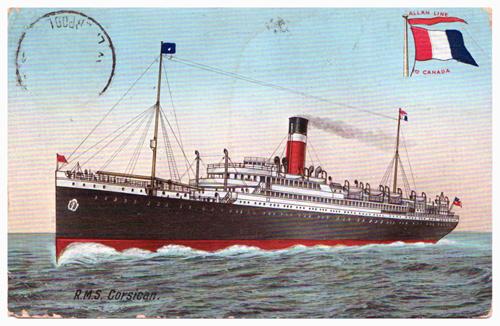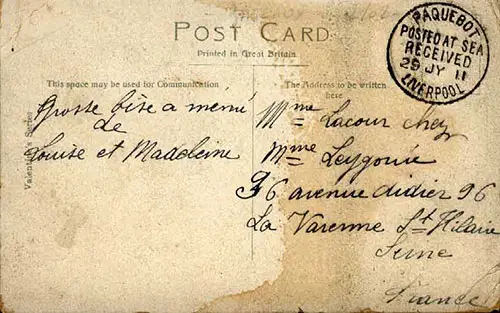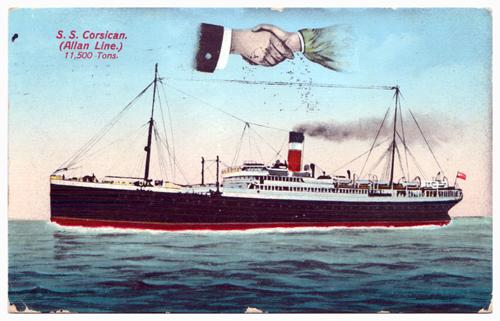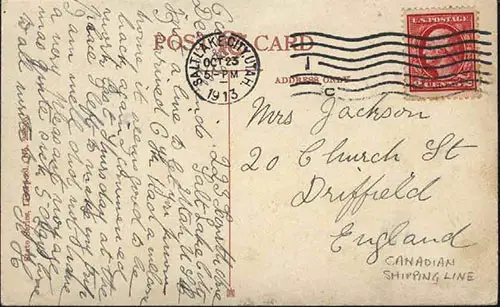Vintage Postcards of the Allan Line Steamship SS Corsican - GG Archives
Vintage Postcards of the RMS Corsican of the Allan Line. Built in 1907 in Glasgow by Barclay, Curle & Co. Ltd. she was 11,500 Gross Tons, Length of 500 Feet and Breadth of 61 Feet. Maiden voyage was on 31 October 1907 from Liverpool to St. John, NB. The ship was utilized by both the Allan Line and Canadian Pacific. The Corsican was a troup ship during the First World War, returning to active passenger services following the war until she was wrecked in 1923.
Vintage Postcard of the RMS Corsican of the Allan Line was postmarked in 1911, color painting of the ship at open sea. Issued from the Valentine's Series, UK.

Archives Inventory Number:AMSA 726775002
Title: RMS Corsican; Allan Line to Canada
Manufacturer: Valentine's Series
Date: Undated but circa 1910
Manufactured: Printed in Great Britain.
Mfg PC Nbr: None
Postmarked: 28 Jul 1911 Liverpool (Paquebot) to France

Hands Across the Sea vintage postcard series of the SS Corcican of the Allan line, registerd at 11,500 tons. Collorized image depects steamship at sea, proceeding at a low rate of speed.

Archives Inventory Number: AMSA 741415688
Repository: GGA-ATL
Title: SS Corsican (Allan Line) 11,500 Tons
Manufacturer: State Series
Date: Undated but circa 1910
Manufactured: Liverpool
Mfg PC Nbr: 202905
Postmarked: 23 Oct 1913 Salt Lake City, Utah to Driffield England

Text of Postcard
Dar Elerends???
Just a line to let you [know] I arrived & then had a welcome home is ??? good to be to be back again I commenced work last Thursday at the place I left to make my trife??? I am well did not have a very pleasant voyage was pretty sick 5 days lone wall write to me. Fe H
The Twin-Screw Allan Liner "Corsican"
The twin-screw steamer Corsican, built by Masers. Barclay, Curie, and Co., Limited, Glasgow. for the Allan Line Steamship Company's Liverpool-Canadian service. The leading particulars of the vessel are:
- Length: 516 Feet
- Breadth: 61 Feet, 3 Inches
- Depth from bottom of keel to top of deck at center: 42 Feet, 9 Inches
- Gross Registered Tonnage: 11,637
- Dead-Weight Carrying Capacity: 11,000 Tons
- Number of First Class Passengers: 300
- Number of Second Class Passengers: 400
- Number of Third Class/Steerage Passengers: 1500
- Horsepower of Machinery on Trial: 9,512 Indicated Horsepower
- Speed on Trial Run: 17.6 Knots
No effort has been spared to obtain construction of the first quality: the vessel not only conforms to the highest class in the British Corporation, but possesses considerable additional strengthening in order to suit the owners' special needs. The hull of the vessel general has been constructed of mild steel (Siemens-Martin open-hearth process).
The hull is divided into separate water-tight compartments by seven bulk-heads, and to further ensure immunity from danger in the event of collision or stranding, a complete inner bottom is fitted, divided by numerous partitions into separate water-ballast tanks, each tank being capable of filled or emptied independently, so that the trim and draught of the vessel can be adjusted at any time to suit the conditions of service.
Four complete steel decks are fitted -- viz, orlop, lower, main, and shelter, the last-named being completely sheathed with pitch-pine, the lower and main being covered with the most modern substitute for wood, "Teramo."
Above the shelter-deck, at the fore-end, is the forecastle deck, providing accommodations for stewards, firemen, and crew. At the after-end is a long combined poop and bridge, sheathed with pitch-pine, forming a promenade, which is partly assigned to second-class passengers and partly to third-class.
Above this is the promenade deck, which is reserved exclusively for first-class passengers, and above this, again, is the upper-bridge deck, on which is placed the officers' quarters: the flying bridge, which is used for navigating purposes, being formed by an extension of the roof of the officers' house.
The first-class dining saloon, a large, roomy apartment, is situated in the deckhouse at the fore end of the bridge deck, occupying the full width: it is lighted by large square windows on three sides. The paneling is in oak, and the ceiling of white enamel, relieved with gold. Adjacent to this is the pantry, in which are installed all the latest devices for perfect service.
A cold chamber is provided on the orlop deck, where perishable provisions may be kept at any desired temperature. On the main deck the commissariat bulks largely in the distribution of space, storerooms for vegetables, fish, dairy produce, potatoes, bacon, etc. bakery, baker's shop, bread room, butcher's shop, and wine room being arranged on this deck.
The music room is on the promenade deck, with all the advantage of light and air that position bestows. Large square windows round three sides provide light, as in the case of the dining saloon. The decoration of the music room is carried out in white, with mural panels of silk, the ceiling being enameled white and picked out in gold.
The first class smoke room, also on the promenade deck, is a large room, well-lighted and ventilated, and is a further aid to ventilation a large teak skylight is fitted above the center of the room. The decoration is in fumed oak with ceiling in white.
The second-class passengers are provided for in a style differing by little from the first class. The dining saloon, which extends right across the ship on the shelter deck, is decorated in white, with a mahogany dado, the natural color of the wood making a pleasant contrast to the general color scheme. The music room is in Mahogany with lincrusta paneling. The smoke room, which is in the same house on the bridge deck as the music room, is in fumed oak.
The electric light installation consists of two independent diosmose, each driven by compound coupled engines. A complete system of electric lighting is fitted throughout the ship, including navigating lights and large clusters for use when discharging cargo at night.
A large chart room and wheel house placed on the flying bridge contain the steering wheel and other navigating contrivances -- compasses, engine room docking and steering telegraphs, and speaking tubes to the engine room -- all proving that the ship is extremely well found in appliances necessary for navigating and working the vessel.
The captain has apartments adjoining the bridge. The engineers are berthed on the shelter deck adjacent to the engine room, with mess room alongside, and lavatories convenient. The crew generally are berthed forward, the firemen on the lower deck and the others on the main and shelter decks.
Part of the shelter deck, main, and lower decks are devoted to the use of third-class passengers, with complete dining accommodation and all conveniences. On the shelter deck is a large, airy saloon extending right across the ship. At different parts of the vessel comfortably fitted up entrance halls, smoke room, and ladies’ cabins are provided for third class and steerage, indicative of the care that the Allan Line Steamship Company have taken to promote the comfort of this class of passenger.
Large tanks capable of containing about 400 tons of fresh water are built into the ship for the service of passengers. The vessel has a dead-weight carrying capacity of about 11,000 tons. Cargo loading and discharging facilities are unusually complete, six large cargo hatches served by twelve powerful winches and derricks, and a powerful warping winch in the steering gear house.
A Weir evaporator, capable of producing 60 tons of water per 24 hours, is installed in the engine room and there are two Hocking distillers of extra-large capacity for the supply of drinking water.
It is of interest to note that the vessel was launched on April 29, and the mooring trial of the machinery carried out by the builders on May 23, or within twenty-one days of the launch. The official trial at sea was made on June 20, when a speed of 17.6 knots was attained, the engines developing 9,512 indicated horsepower. The vessel is now on the Liverpool-Canada service.
Excerpts from “The Twin-Screw Allan Liner Corsican,” Engineering: An Illustrated Weekly Journal, London, Volume 85, January 24, 1908: 111-112
